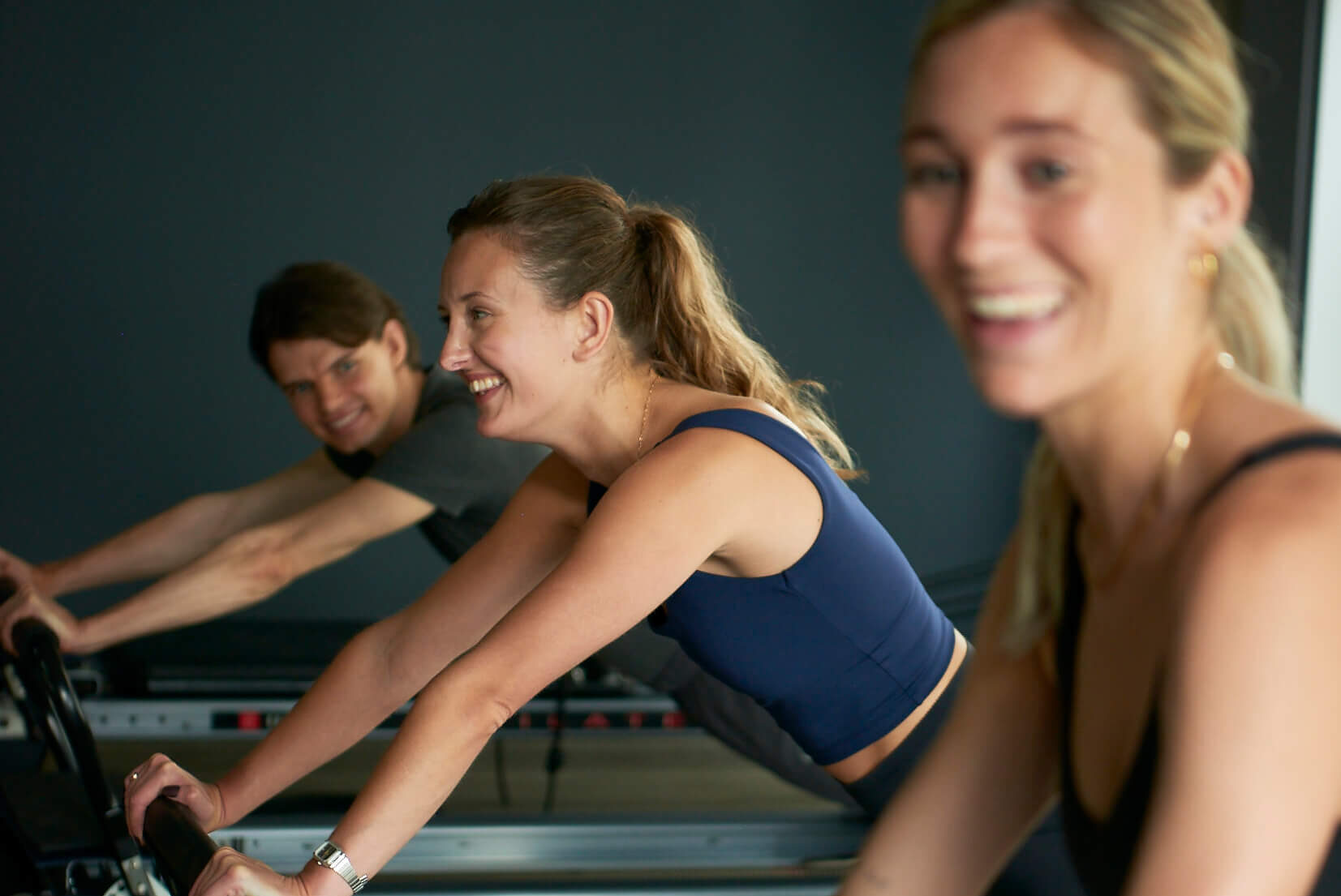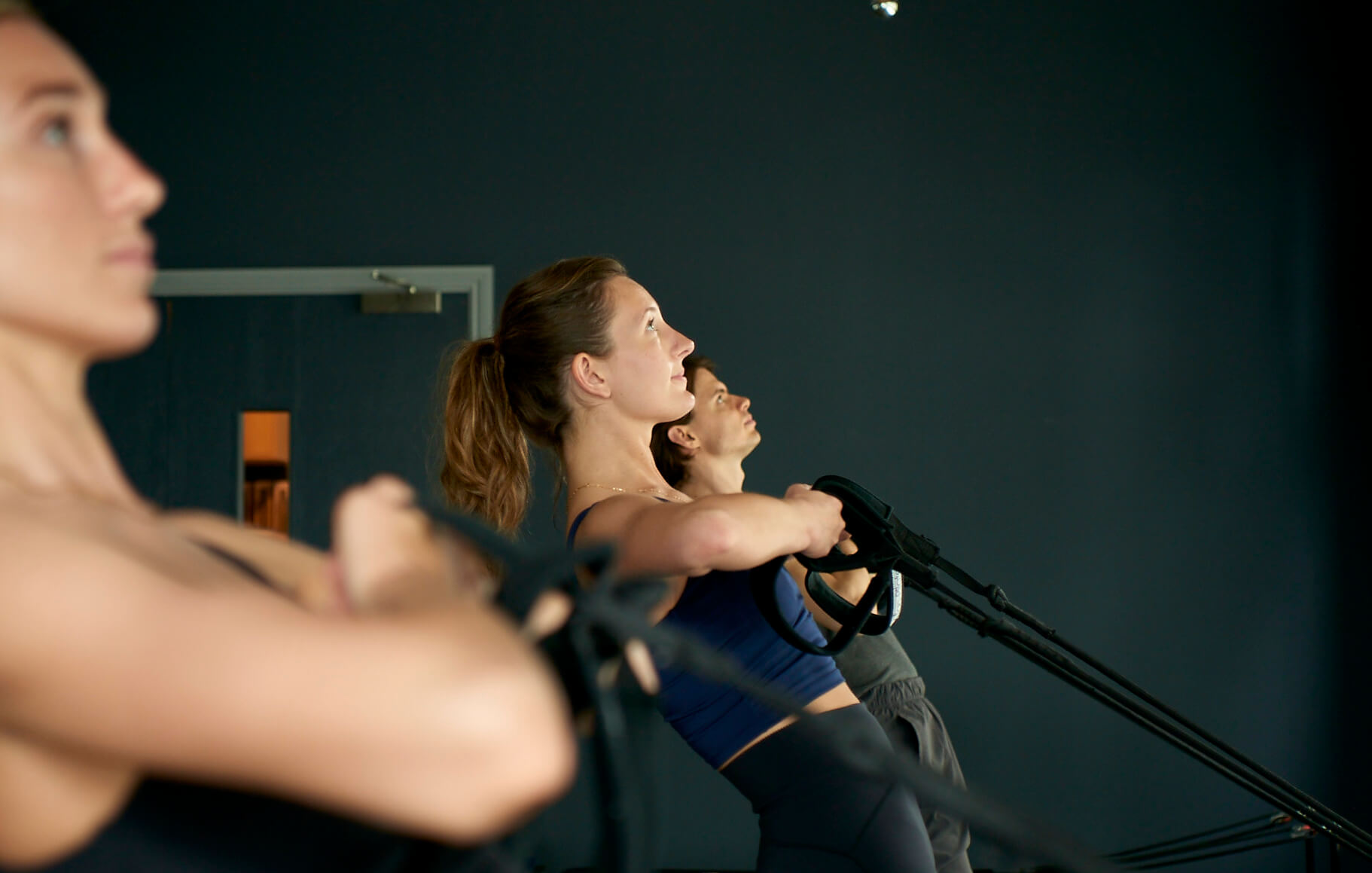Pilates is the perfect method to support your body; through a combination of strength, mobility, and flexibility – with every exercise keeping your core engaged. Centering is one of the main principles of Pilates: bringing focus and stability to the centre of the body. Discover how to activate your ‘powerhouse’ with a series of core-strengthening movements.
What is the core?
The core is the centre of the body, consisting of muscles that maintain the stability of the pelvis and spine, influencing both the legs and upper body. In anatomy, the core refers (in its most general of definitions) to the body minus the legs and arms.
Why is it so important to have a strong core?
A strong, healthy core enables you to maintain a better posture and form during exercise whilst strengthening and stabilising your lower back and improving balance. Functional movements are highly dependent on the core – with a lack of core development resulting in a predisposition to different issues and injuries, such as lower back pain, hip pain and pelvic pain. A weak core may cause other muscle groups to overwork, putting too much pressure on your joints and causing pain and discomfort.
How can doing Pilates strengthen your core?
Pilates focuses on your core in addition to strengthening and toning your muscles and increasing flexibility. It is a great way to maintain your overall fitness. Your core is engaged at all times during a Pilates session, with a wide range of muscle groups targeted; from the internal transverse abdominis to the rectus abdominis.
What are the best pilates exercises to strengthen your core?
The below exercises are all classic mat Pilates moves that don’t require equipment. Whether you’re a Pilates pro or new to the method, you will reap the benefits of our tried and tested core movements.
It is important to remember the main Pilates principles during the following exercises. Ensure to maintain an awareness of your alignment whilst controlling your breath and engaging your abdominal muscles. Remember to target your deep stabilisation muscles – and find a balance between momentum and flow.

TOE TAPS
Muscles targeted: Rectus Abdominis, Transverse Abdominis, Obliques, Hip Flexors, Hamstrings and Gluteal Muscles.
Step-by-step instructions:
- Lie down on a Pilates mat on your back with your knees bent and arms by your sides.
- Bring your legs to tabletop (one leg at a time) with your knees bent at 90-degrees, and your calves parallel to the floor.
Good to know: Ensure you maintain a neutral spine; do not arch your back or press your back into the floor. - Start by lowering your right foot to the ground and tapping it on the floor while keeping your left leg in tabletop position.
- Bring your right leg back to tabletop and repeat the movement with your left leg.
- Repeat exercise for 10 taps on each side.
Benefits: Strengthening your core and abdominal muscles and helping to boost energy.
Regression: Keep the non-moving toe on the mat (rather than in tabletop), while tapping with the opposite foot.
Progression: For more of a challenge tap both feet on the mat at the same time.
SINGLE LEG STRETCH
Muscles Targeted: Rectus abdominis, Quadriceps, Obliques and Hip Flexors.
Step-by-step instructions:
- Lie down on a Pilates mat on your back with your knees bent and arms by your sides.
- Bring your legs to tabletop (one leg at a time), with your knees bent at 90-degrees, and your calves parallel to the floor.
- Exhale and lift your head (keep it tucked towards your chest), and roll up using your abdominal muscles, curling your upper spine up off the floor to the base of your shoulder blades.
- As you curl up, extend your left leg at a 45-degree angle (about 3-4 inches off the floor). Keep your right leg in tabletop position, grasp your right ankle with your right hand and move your left hand to your right knee.
Good to know: Continue to keep your upper-body curved throughout this exercise, keeping your shoulders relaxed and pulling your navel in towards your spine. - Hold this position for a second or two during inhale and then exhale and switch legs; hold your bent leg by the ankle with your outside hand whilst your other hand moves to the inside of your knee.
- Repeat the exercise, switching legs up to 10 times.
Benefits: Training your abdominal muscles to support and stabilise; whilst learning to coordinate your arms and legs.
Regression: You can do this exercise with your head on the floor. If the small of your back is rising off the floor, your legs are too low – to rectify this, raise your legs so that you are working your abdominal muscles, and not your back.
Progression: To make this movement more of a challenge, you can lower your legs and/or raise your head and shoulders.
ROLL UP
Muscles Targeted: Rectus abdominis, Transverse Abdominis, Obliques, Hip flexors and Lower Back Muscles.
Step-by-Step Instructions:
- Lie down on a Pilates mat on your back with your legs flat on the floor. Extend your arms overhead so they are flat on the floor behind you, with your head resting between them and inhale.
- Exhale and bring your arms overhead in an arc. When your arms move past your ears, begin to curl your head, neck and shoulder blades off the mat and inhale making sure to engage your abdominal muscles.
- Exhale as you roll up the rest of the way, in one smooth motion to curl your body up and over towards your toes
- Once you have rolled all the way up, pause with your fingers reaching towards your toes
Good to know: Ensure your spine is curved in a “C” shape and keep your arms lifted and parallel to the floor - Exhale and roll back down to the mat, vertebrae by vertebrae, to the starting position.
Benefits: Helping to strengthen your core, stretching the spine and increasing flexibility.
Regression: Bend your knees or use a bolster under the legs to relieve your hip flexors
Progression: To make this exercise more challenging you can use a Pilates circle and squeeze as you roll up and down
THE HUNDRED
Muscles Targeted: Rectus Abdominis, Transverse Abdominis, Obliques, Quadriceps, Hip Flexors, Pelvic Floor, Lats and Deltoids.
Step-by-Step Instructions:
- Lie down on a Pilates mat on your back with your knees bent and arms by your sides.
- Bring your legs to tabletop (one leg at a time), with your knees bent at 90-degrees, and your calves parallel to the floor.
- Inhale and reach your arms in a straight line, up to the sky, with your palms facing forward.
- Exhale and reach your arms back down to the floor whilst lifting your head (keep it tucked towards your chest), and roll up to the using your abdominal muscles, curl your upper spine up off the floor to the base of your shoulder blades.
- Stay here and inhale.
- Exhale whilst deepening the pull of the abs and straightening your legs.
Good to know: Do not lower your legs too far – if you begin shaking or your lower spine pulls up from the floor, lower your legs to a more comfortable position. - Hold your position and inhale deeply for 5 breaths, moving your arms in an upward and downward motion controlled by your breaths.
- Then exhale for 5 breaths – this is a full cycle of 10 breaths: 10 breaths is 100 total beats (5 for each inhale and 5 for each exhale).
Benefits: The hundred is a great way to warm-up your abdominal muscles and lungs, requiring coordination of breath and movement.
Progression: To make the hundred more challenging, lower your legs, but only as far as is possible for you
Regression: Your legs can be in tabletop rather than extended. Alternatively, your legs can be in an extended position, but with your head and shoulders on the floor.
TEASER
Muscles targeted: Pelvic floor, Rectus Abdominis, Transverse Abdominis, Obliques Hip Flexors and Quadriceps.
Step-by-step instructions:
- Lie down on a Pilates mat on your back with your legs flat on the floor. Extend your arms overhead with your head resting between them.
- Lift your legs straight to a 45-degree angle, lifting your head, neck, shoulders and upper back whilst engaging your abdominals.
- Lift your arms in line with your shoulders, with palms facing downward.
- Raise your legs and torso further so you are now sitting in an upright ‘V’ position on your sit bones, remembering to relax your shoulders.
Good to know: your upper spine should be fully lengthened, and your lower spine should be slightly curved. - To complete the movement, slowly round through your spine and lower back down, one vertebra at a time, returning to your starting position.
Benefits: Improving strength, balance, flexibility and spinal mobility.
Regression: Your knees can be bent, with your feet on the mat, just working on extending one leg at a time.
Progression: To challenge yourself, extend your arms overhead whilst lowering and lifting your legs.
SIDE PLANKS WITH HIP DIPS
Muscles targeted: Transverse Abdominis, Gluteus Medius, Gluteus Maximus, Deltoids, Scapula Stabilisers and Lats.
Step-by-step instructions:
- Lie on your side on a Pilates mat, propped up onto your forearm, with your top arm on your hip.
- Begin in a side plank position, with one foot stacked on top of the other.
- Exhale, lifting your hips and forming a straight line from your shoulders through to your ankles
- Hold this position for 30 seconds
Good to know: Ensure your elbow remains in alignment with your shoulder. - Exhale and dip your hips down toward the ground (with your belly button tucked in)
- Inhale and lift your hips back up in a controlled movement
- Keep your core engaged throughout, so your hip does not rest on the floor at the bottom of the dip
- Repeat exercise 10 times before switching to the left side.
Benefits: Improving balance, strengthening and lengthening muscles.
Regression: Place one foot slightly in front of the other, rather than stacked on top of each other, to give you more support. You could modify the side plank further by dropping to your knees.
Progression: For a more challenging hip dip exercise, lift your top arm to the sky whilst keeping both legs straight.
Good to Know: All of the above exercises can also be performed on the Pilates Reformer.
Please note: If you have any injuries, health issues or are pregnant, please speak to your doctor, physical therapist and pilates instructor regarding which exercises are best for you.
Focus on your core strength today, either at home or by attending Pilates classes, to refine your posture, reduce your risk of injury, enhance sports performance and even improve your everyday activities.

